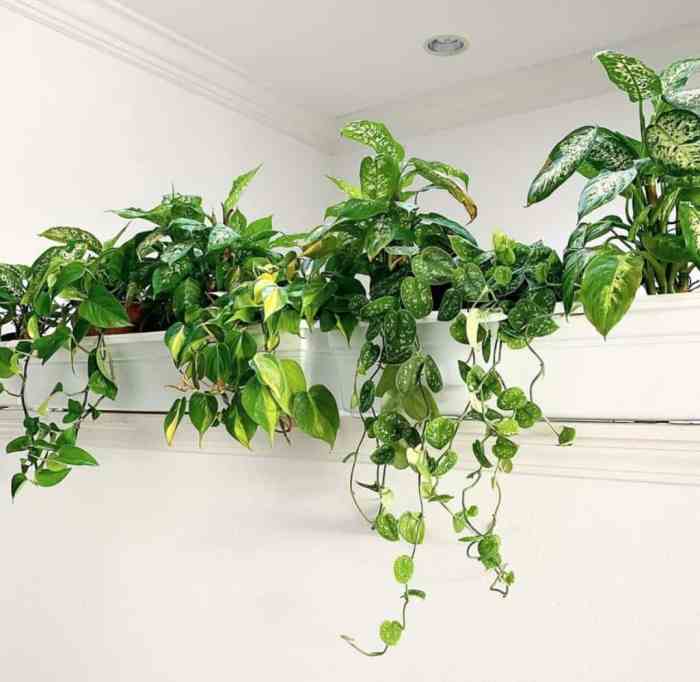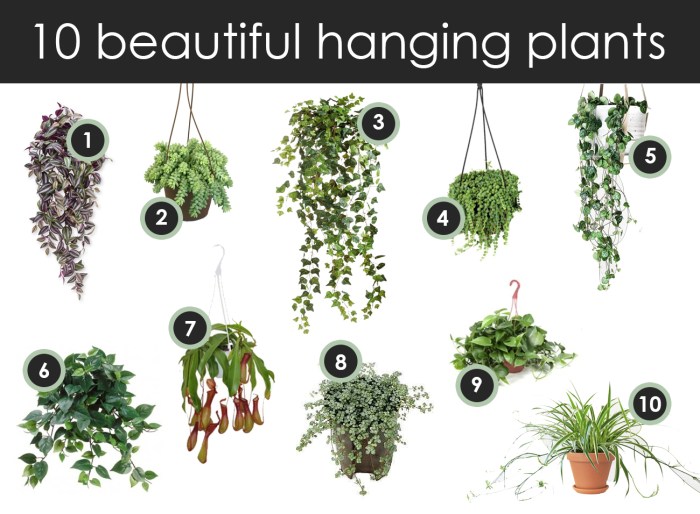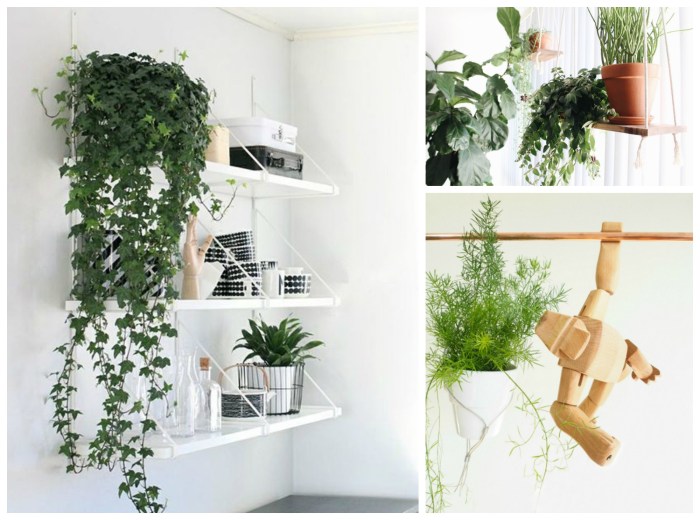10 hanging plants low water: Discover the ultimate guide to thriving greenery with minimal effort. This comprehensive list introduces you to a world of low-maintenance plants that will elevate your indoor spaces with their beauty and resilience.
From botanical names to care tips, this article provides everything you need to know about these water-wise wonders. Get ready to transform your home into a lush oasis without the hassle of constant watering.
Low-Water Hanging Plants
When selecting plants for a hanging basket, consider species that can tolerate low watering. These low-maintenance plants will thrive with minimal attention, making them ideal for busy individuals or those who prefer hassle-free gardening.
Here’s a comprehensive list of 10 hanging plants that are known for their drought tolerance:
Spider Plant (Chlorophytum comosum)
- Commonly known as the spider plant, this species is known for its long, cascading leaves with variegated patterns.
- It can tolerate infrequent watering and prefers bright, indirect light.
Burro’s Tail (Sedum morganianum)
- This succulent plant features long, trailing stems with plump, fleshy leaves that resemble a donkey’s tail.
- It thrives in well-draining soil and requires minimal watering, making it an excellent choice for dry environments.
String of Pearls (Senecio rowleyanus)
- The string of pearls plant is characterized by its long, trailing stems adorned with small, spherical leaves that resemble pearls.
- It prefers bright, indirect light and can tolerate long periods of drought.
Trailing Jade (Crassula ovata)
- This succulent plant features thick, glossy leaves and trailing stems.
- It prefers well-draining soil and can tolerate occasional watering.
Golden Pothos (Epipremnum aureum)
- The golden pothos is a popular choice for hanging baskets due to its trailing vines and variegated leaves.
- It is known for its hardiness and can tolerate infrequent watering.
Heartleaf Philodendron (Philodendron scandens)
- This philodendron species features heart-shaped leaves and trailing stems.
- It prefers bright, indirect light and can tolerate some drought.
Peperomia obtusifolia
- This compact plant features thick, fleshy leaves and can tolerate low watering.
- It prefers bright, indirect light and well-draining soil.
Moses-in-the-Cradle (Tradescantia spathacea)
- This plant features variegated leaves and can tolerate low watering.
- It prefers bright, indirect light and well-draining soil.
Spiderwort (Tradescantia zebrina)
- This plant features purple-green leaves with silvery stripes and can tolerate low watering.
- It prefers bright, indirect light and well-draining soil.
Baby’s Tears (Soleirolia soleirolii)
- This low-growing plant features tiny, round leaves and can tolerate low watering.
- It prefers bright, indirect light and well-draining soil.
Watering Requirements

Hanging plants with low water needs thrive in environments with minimal moisture. Understanding their specific watering requirements is crucial for their optimal growth and longevity. Different species have varying tolerances to dryness, so it’s essential to tailor the watering schedule accordingly.
If you’re looking for low-maintenance plants that can thrive with minimal watering, consider hanging plants. They come in various types, including those that can tolerate low light conditions. For those who prefer indoor greenery with low light requirements, check out 10 hanging plants indoor low light . Meanwhile, if you’re short on time or forgetful about watering, consider adding some low-water hanging plants to your home.
Overwatering can lead to root rot and fungal diseases, while underwatering can stunt growth and cause leaf drop. The key is to find a balance that meets the plant’s individual needs.
Frequency and Amount
- Spider Plant (Chlorophytum comosum):Water every 1-2 weeks, allowing the soil to dry out slightly between waterings.
- Snake Plant (Sansevieria trifasciata):Water every 2-3 weeks, or even less frequently during winter.
- ZZ Plant (Zamioculcas zamiifolia):Water every 2-4 weeks, or less frequently during winter.
- String of Pearls (Senecio rowleyanus):Water every 1-2 weeks, allowing the soil to dry out completely between waterings.
- Air Plant (Tillandsia):Mist lightly once a week or soak in water for 10-15 minutes every 2-3 weeks.
Techniques
- Water thoroughly:When watering, soak the soil until water drains from the bottom of the pot.
- Allow excess water to drain:Never let plants sit in waterlogged soil.
- Use a moisture meter:A moisture meter can help determine when the soil is dry enough to water.
- Mist regularly:Misting can help increase humidity around the plant, especially for air plants.
Hanging Methods
Hanging plants can add a touch of greenery and life to any space. There are a variety of ways to hang plants, and the best method will depend on the type of plant, the size of the pot, and the desired look.
Here are a few tips on how to hang plants effectively:
Macrame Hangers
Macrame hangers are a popular choice for hanging plants because they are both stylish and functional. Macrame is a type of knotting that can be used to create a variety of different patterns and designs. Macrame hangers can be made from a variety of materials, including cotton, jute, and hemp.
They are typically hung from the ceiling or a hook, and they can be adjusted to different lengths.
Hanging Baskets
Hanging baskets are another popular option for hanging plants. They are typically made from wicker, metal, or plastic, and they come in a variety of shapes and sizes. Hanging baskets can be hung from the ceiling or a hook, and they can be used to create a variety of different looks.
One advantage of hanging baskets is that they can be easily moved around, which makes it easy to change the look of your space.
Hanging Pots
Hanging pots are a great option for hanging small plants. They are typically made from ceramic, metal, or plastic, and they come in a variety of shapes and sizes. Hanging pots can be hung from the ceiling or a hook, and they can be used to create a variety of different looks.
One advantage of hanging pots is that they are easy to water, which makes them a good choice for busy people.
Creating Attractive and Functional Hanging Displays
When creating a hanging display, it is important to consider the following factors:
- The size and weight of the plant
- The type of hanging container
- The desired look
It is also important to make sure that the hanging display is safe and secure. Here are a few tips for creating attractive and functional hanging displays:
- Use a variety of different hanging containers to create a visually interesting display.
- Hang plants at different heights to create a sense of depth.
- Group plants together by type or color to create a cohesive look.
- Make sure that the hanging display is safe and secure.
Light and Temperature Requirements: 10 Hanging Plants Low Water

Understanding the ideal light and temperature conditions for hanging plants is crucial to ensure their optimal growth and well-being. Insufficient or excessive light and temperature can lead to stress, affecting their overall health and appearance.
Light Requirements, 10 hanging plants low water
Most hanging plants thrive in bright, indirect light. Direct sunlight can scorch leaves, while low light conditions can hinder growth and lead to leggy stems.
If you’re looking for low-maintenance hanging plants, consider these 10 varieties that thrive with minimal watering. These plants are perfect for busy individuals or those who prefer a more hands-off approach to gardening. For more indoor hanging plant options, explore our comprehensive guide to 10 hanging plants inside . Whether you’re a seasoned plant enthusiast or just starting out, this resource provides valuable insights into choosing the perfect hanging plants for your indoor space.
Remember, with these low-water hanging plants, you can enjoy the beauty of greenery without the hassle of constant watering.
Signs of insufficient light include:
- Stunted growth
- Yellowing leaves
- Leggy stems
Excessive light can cause:
- Leaf scorch
- Brown or crispy leaf tips
Temperature Requirements
Hanging plants prefer moderate temperatures ranging from 65 to 85 degrees Fahrenheit (18 to 29 degrees Celsius). Extreme temperatures can damage leaves and hinder growth.
Signs of insufficient temperature include:
- Wilting leaves
- Dropping leaves
Excessive temperature can cause:
- Leaf burn
- Stunted growth
When selecting a location for hanging plants, consider the amount of natural light available and the ambient temperature. Adjust the placement or provide additional light or temperature control as needed to ensure optimal conditions.
If you’re looking for low-maintenance greenery, consider hanging plants that require minimal watering. From the delicate maidenhair fern to the air-purifying spider plant, these easy-care varieties will add a touch of nature to your home. And if you’re looking for more hanging plant inspiration, check out 10 hanging plants house for a wider selection of beautiful and easy-to-grow options.
Additional Care Tips

Maintaining the health of low-water hanging plants involves general care practices like fertilizing, pruning, and pest control. Additionally, each plant on the list may have specific maintenance requirements.
Fertilizing these plants once a month during the growing season with a balanced liquid fertilizer diluted to half strength is generally sufficient. Pruning should be done as needed to remove dead or damaged leaves or stems, and to shape the plant.
Regular inspection for pests is crucial, and if any are found, appropriate measures should be taken to control them.
Fertilizing
- Fertilize once a month during the growing season with a balanced liquid fertilizer diluted to half strength.
Pruning
- Prune as needed to remove dead or damaged leaves or stems.
- Prune to shape the plant.
Pest Control
- Regularly inspect for pests.
- Take appropriate measures to control pests if found.
Final Conclusion

In conclusion, 10 hanging plants low water offers a practical and inspiring solution for those seeking to add a touch of nature to their homes without the burden of high maintenance. These plants not only enhance the aesthetics of any space but also purify the air, creating a healthier and more inviting environment.
Embrace the beauty of low-water hanging plants and enjoy the tranquility they bring to your daily life.
FAQ Guide
What are the benefits of hanging plants with low water needs?
Hanging plants with low water needs offer several benefits, including reduced maintenance, improved air quality, and enhanced aesthetics. They are ideal for busy individuals or those who travel frequently.
How often should I water my hanging plants?
Watering frequency depends on the specific plant and environmental conditions. As a general rule, water when the top inch of soil feels dry to the touch. Allow excess water to drain out to prevent root rot.
What are some tips for hanging plants effectively?
Use sturdy hooks or brackets to support the weight of the plant and its container. Consider using macrame hangers or baskets for a decorative touch. Ensure the plant has adequate space to grow and receives sufficient light.